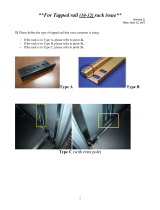
RFT2 Rack Kit Installation Guide
07/01/06 Rev 1.0 Page 13 of 13
Warranty
Neuro Logic Systems warrants to the original retail purchaser that this product is and will be free from defects in
materials and workmanship for a period of 24 months from the date of purchase. During the warranty period,
purchaser must promptly call Neuro Logic Systems (+1.805.389.5435) to log any such defects in materials and
workmanship. If you purchased the unit from a distributor or reseller, contact them first as they may be able to
assist you.
The warranty is void under the following conditions:
1. If non-Neuro Logic Systems approved cabling is attached to the product. Poorly constructed and/or
miswired cabling can diminish video quality and damage equipment. Neuro Logic available cabling is built
to high quality standards utilizing overall braided shield to comply with FCC emission standards, and each
cable is individually tested under load.
2. If abuse, mishandling, unauthorized repair, or use other than intended has caused the product to be
defective or malfunction.
3. If unauthorized modifications were made to product.
4. If unreported damages occurred in any shipment of the product.
5. If damages were due to/caused by equipment or software not provided by Neuro Logic Systems.
6. If the product is used with non-grounded or incorrectly polarized AC power.
EXCEPT AS SPECIFICALLY PROVIDED ABOVE, NEURO LOGIC SYSTEMS MAKES NO WARRANTIES
EITHER EXPRESS OR IMPLIED AS TO ANY MATTER WHATSOEVER, INCLUDING, WITHOUT LIMITATION,
THE CONDITION OF THE PRODUCT, ITS MERCHANTABILITY, OR ITS FITNESS FOR ANY PARTICULAR
PURPOSE. EXCEPT AS EXPRESSLY PROVIDED ABOVE, NEURO LOGIC SYSTEMS SHALL NOT BE LIABLE
FOR LOSS OF PROFIT, LOSS OF BUSINESS, SPECIAL OR CONSEQUENTIAL DAMAGES, OR OTHER
FINANCIAL LOSS WHICH MAY BE CAUSED BY, DIRECTLY OR INDIRECTLY, THE INADEQUACY OF THE
PRODUCT FOR ANY PURPOSE OR USE THEREOF OR BY ANY DEFECT OR DEFICIENCY THEREIN EVEN
IF NEURO LOGIC SYSTEMS OR AN AUTHORIZED NEURO LOGIC SYSTEMS DEALER HAS BEEN ADVISED
OF THE POSSIBILITY OF SUCH DAMAGES OR LOSSES.
Nothing in these terms will reduce your statutory rights.
















